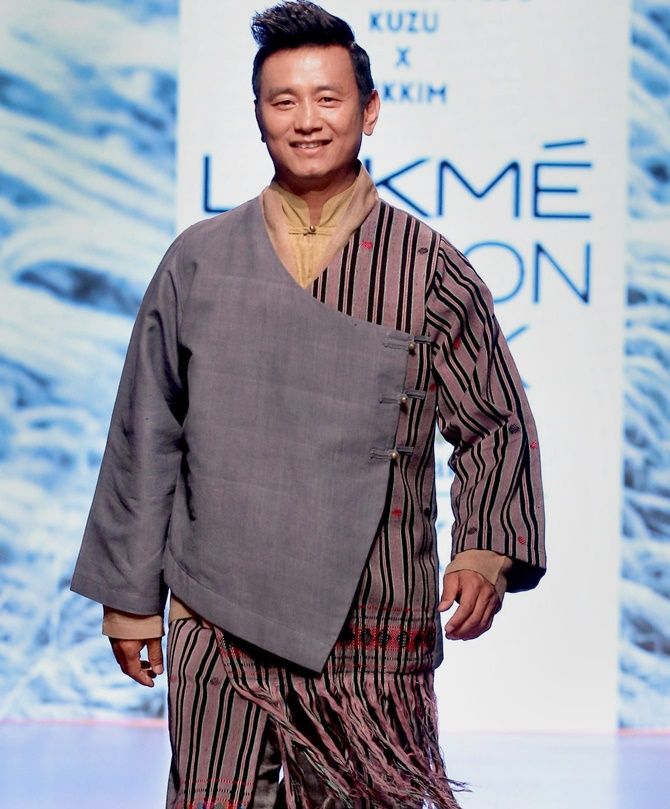Can Baichung Bhutia's Hamro Sikkim party pose a challenge to Pawan Chamling who has not lost an election in 24 years?
Aditi Phadnis reports.

Last month, Pawan Kumar Chamling, chief minister of Sikkim, became India's longest-serving chief minister ever.
And, entirely appropriately, football legend Bhaichung Bhutia was in Delhi to announce a new political party in Sikkim that would challenge Chamling's regime.
Given Chamling's political longevity, this is a formidable task.
If Chamling is a Nepali-speaking native of Sikkim, so is Bhaichung Bhutia.
Not only that, he is much younger, more energetic and not an entire political novice.
But Bhutia has not won too many elections. He joined the Mamata Banerjee-led Trinamool Congress in 2013, contested the Lok Sabha election in 2014 from Darjeeling and lost to the Bharatiya Janata Party's S S Ahluwalia by nearly 200,000 votes.
His loss was attributed to the non-Nepali population from the plains that voted overwhelmingly for the BJP.
But in 2016, he contested the assembly election from Siliguri and lost that as well -- this time to the CPI-M's Asok Bhattacharya.
In February this year he announced he was resigning from the TMC. A month later, he announced the launch of his political party, Hamro Sikkim (Our Sikkim).
The Sikkimese sniper had struck!
But has he?
Sikkim illustrates a simple truth -- identity politics can succeed, but only up to a point. You need performance as well.
Bhutia's point at the launch of Hamro Sikkim was that the state may have done well but it had the highest suicide rate in India, suggesting lack of employment and general below par conditions of existence.
That doesn't seem quite right. You only have to read the 2014 Sikkim Human Development Report produced by a UNDP affiliate to understand the miracle.
The HDR 2014 says between 2001 and 2012, Sikkim's net state domestic product grew, on average, by 17 per cent every year -- the highest among all Indian states -- surpassing significantly the national average of 10 per cent.
In a recent interview to India Today magazine, Chamling said: 'I don't want Sikkim to be a consumer state. Our development model is based on utilising human and natural resources. It began with the launch of ecotourism and blending it with the promotion of local culture.'
'The next step was making the state organic. Initially, it was difficult to convince people, motivate bureaucrats and replace chemical fertiliser with organic. This not only boosted the rural economy but also increased life expectancy by 10 years.'
'Agriculture contributes 50 per cent to CO2 emission. If we stop using chemical fertiliser, it will reduce CO2 emission. We hope to be self-sufficient in foodgrain production in the next five years.'
'Development can never be at the cost of environment. Sikkim has many power projects, but only seven households were displaced due to these dams.'
Sikkim's per capita income today is the highest among the north eastern states and ranks fifth in India (after Delhi, Goa, Chandigarh and Puducherry).
In the 2018-19 budget, Chamling emphasised the creation of physical infrastructure -- the bulk of the budget was set aside for the upgradation of roads.
Of course, there is identity politics at work as well.
The original settlers in Sikkim were the Lepchas. But it was the Nepali-speaking Bhutias who subjugated the Lepchas for three centuries.
In the process other tribals like Limbus and Tamangs, were denied equal rights.
According to Chamling, the rebellion against the Chogyal was actually a revolution that overthrew oppressive Qazi rule and radicalised scores of young men across Sikkim.
The first dewan of Sikkim, John Lall, described it somewhat differently. Instead of honouring Sikkim's sovereignty and China's feelings, India imported mobs of Nepali-speaking people from Darjeeling and Kalimpong, told the Chogyal that his people had rebelled against him and annexed Sikkim.
Believe the version of history you will.

But after the overthrow of the Chogyal, Narbahadur Bhandari went on to become chief minister. When Chamling won his assembly seat, Damthang, polling 96.6 per cent of the vote in the 1989 assembly elections, Bhandari sought to co-opt Chamling by making him a minister in the state government.
Chamling had other ambitions.
After two-and-a-half years of ministership, he quit the Bhandari government in 1993 and formed a new regional party, the Sikkim Democratic Front.
In the 1994 assembly elections, the SDF won 19 out of 32 seats.
In 1999, it won 25 seats out of 32.
In 2004, it won 31 out of 32 seats in the Sikkim assembly and in 2009 it won all 32.
How did Chamling achieve this? He fought for and won a struggle to extend reservations to castes like Limbus and Tamangs.
In Sikkim, 20 per cent of the population is Bhutia-Lepcha and 40 per cent comprises Other Backward Castes. Added are the Newars, a prosperous caste engaged in business. Limbus, Rais and Tamangs are around 20 per cent of the population.
When they were included in the reservation net, they became Chamling's natural constituency. But rivals were snapping at the heels.
In 2014, the SDF won only 22 out of 32 seats: It yielded space to the Sikkim Krantikari Morcha.
Now, another challenger has appeared. The assembly election in 2019 should be interesting.










